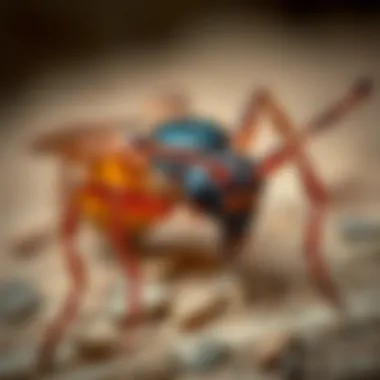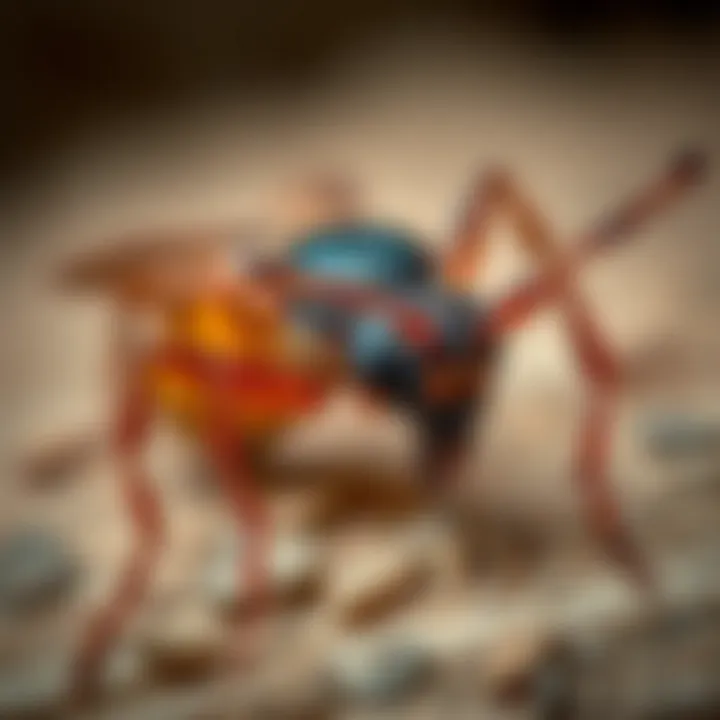Effective Pest Control Methods in Tinley Park


Intro
In Tinley Park, homeowners often face the delicate dance of maintaining a serene living environment while fending off pesky intruders like ants, rodents, and various other unwelcome critters. This guide is crafted to shed light on effective pest control methods, providing detailed insights into how one can prevent, identify, and manage these nuisances safely and sustainably. The focus is not just on eliminating pests but on fostering an understanding of their behaviors and biology to promote lasting solutions.
Understanding the Pest
Identification
Knowing what you're dealing with is half the battle in pest control. Different pests have distinct habits, appearances, and potential threats to your home. In Tinley Park, you might encounter pests like the Carpenter Ant, which loves the wood in and around buildings, or the common House Mouse, which can sneak in unnoticed. By understanding these critters—what they look like, where they live, and their food preferences—you can better strategize how to manage them. Common indicators of an infestation include droppings, gnaw marks, and unusual noises during the night. These signs can guide homeowners toward identifying the specific pest at hand.
Life Cycle
Pest life cycles significantly influence management strategies. For example, bed bugs reproduce quickly; a single female can lay up to 500 eggs during her lifetime. Knowing the life cycle helps in choosing the right method of control at the right time. By understanding how long pests take to reach maturity and reproduce, homeowners can time their interventions effectively to break the cycle before it spirals out of control. For instance, targeting the larvae phase of pests might yield better results than just treating adults. It's a tactical game of patience and timing.
Pest Prevention Strategies
Environment Modification
One of the best ways to keep pests at bay is by modifying their environment. This involves taking a step back and looking at your space critically. Are there overgrown shrubs near your home? Is your trash can easily accessible outdoors? Simple modifications—sealing cracks, keeping food stored securely, and reducing clutter—can drastically reduce the likelihood of infestations. Ensuring that your yard is tidy and that standing water is drained can also hinder the breeding of mosquitoes and other pests. Effective pest control starts from the ground up.
Physical Barriers
Investing in physical barriers is a smart move. Screens on windows and doors, caulking gaps, and using mesh for vents can keep pests outside where they belong. These barriers act as the first line of defense, making it harder for unwanted visitors to breach your personal sanctuary. Maintaining these barriers is crucial; even a tiny tear can be an open invitation to ants and other small critters.
Control Methods
Chemical Control
Should preventive measures fall short and pests invade your home, chemical control methods may be necessary. However, it's essential to approach this option with caution. The use of insecticides or rodenticides can be effective, yet the selection and application must be done with care, especially in households with pets or children. Always read labels for instructions and safety information, and consider consulting with a pest management professional who can provide guidance on the most suitable products for your specific situation.
Biological Control
On the flip side of the chemical spectrum is biological control, an eco-friendly approach that utilizes natural predators to keep pest populations in check. For instance, introducing ladybugs can naturally reduce aphid populations in gardens. Moreover, maintaining a diverse ecosystem can contribute to a healthy balance, minimizing reliance on chemical methods. Understanding the role of beneficial insects and birds in pest control is crucial in fostering a balanced and thriving environment.
In summary, understanding the various pest control methods available in Tinley Park can greatly empower homeowners. It's not just about retaliation but forming a comprehensive game plan that emphasizes prevention and education. Engaging with neighbors and local communities about their experiences can also offer invaluable insights into maintaining a pest-free home. By staying informed and proactive, you're less likely to share your space with unwanted guests.
Prolusion to Pest Control in Tinley Park
Pest control isn't just a mere inconvenience; it's a matter of maintaining the sanctity of our homes and gardens. In Tinley Park, homeowners find themselves in a unique battle against a variety of pests that come and go with the seasons. Understanding the need for effective pest control methods is essential for our well-being and the health of our living spaces.
The local climate, diverse fauna, and even urban development play significant roles in the pest landscape. With pests lurking around, they can damage property, pose health risks, and spoil the joy of growing a beautiful garden. Ignoring these issues can lead to bigger headaches down the road.
Importance of Pest Control in Tinley Park
Engaging in proactive pest control has numerous benefits. For starters, getting ahead of potential infestations can save homeowners a lot of money in repairs and treatments later on. Knowing which pests are most common and how they behave equips residents to protect their properties better. More than just a habit, it's a necessary lifestyle choice for the residents who cherish their homes.
Moreover, controlling pests effectively can dramatically enhance the quality of life. A pest-free environment boosts comfort, allows for peaceful gatherings, and encourages outdoor activities. Families can enjoy barbecues in their backyards without the nagging worry of biting pests or other nuisances ruining the fun.
When it comes to pest control, it’s not about greeting them with a heavy hand or intense chemicals. Many local residents have now embraced the concepts of eco-friendly methods and integrated pest management. This not only manages the pests but also protects our beloved environment.
In symbiosis with these practices, educating oneself about pest behavior forms a critical aspect of pest control. Just acknowledging when and where pests are most active leads to small yet effective changes in housekeeping routines that can keep infestations at bay.
Key Considerations
Before setting foot in a journey towards pest management, several pivotal elements must be kept in mind:
- Education: Learn about the common pests in Tinley Park, their habits, and their habitats. This foundational knowledge informs strategies.
- Identification: A solid identification of the pests you are dealing with can help tailor the most effective methods for removal or deterrence.
- Sustainable Practices: Emphasizing eco-friendly approaches aligns pest control with global sustainability efforts, which are becoming increasingly more relevant.
In summary, understanding pest control in Tinley Park is not just beneficial—it's vital. This article aims to demystify the pest situation and provide practical solutions for residents looking to fortify their homes against unwelcome critters. Remember, when you stay one step ahead of pests, you create a harmonious living space that you and your family can truly enjoy without worry.
Understanding the Local Pest Landscape
Getting a grip on the local pest landscape is not just a good idea; it’s essential for anyone looking to maintain a pest-free environment at home. When homeowners and gardeners in Tinley Park know which pests are lurking around the corner and their habits, they can tweak their pest management strategies effectively. Being informed removes a great deal of the guesswork from dealing with unwanted critters.


Common Pests Found in Tinley Park
Tinley Park has its fair share of common pests, each with unique traits and behaviors that can affect homes and gardens alike. Knowing these pests can help homeowners take preemptive action.
- Ants: Fierce foragers often seen marching in lines, these pests can invade kitchens and gardens. The most common types here include odorous house ants and pavement ants. Their presence can lead to unsightly trails and, much to the dismay of homeowners, the possibility of a deeper colony thriving nearby.
- Termites: These wood-eating insects do their damage quietly. By the time you see signs of them, the wood in your home might be already compromised. In Tinley Park, species like the eastern subterranean termite are particularly common, making timely inspection vital.
- Cockroaches: Particularly the German cockroach, these pests thrive in warm, humid environments. They can often be found in kitchens or bathrooms where food crumbs and moisture are abundant. They don’t just gross people out, they can carry diseases too!
- Bed Bugs: Once confined to hotels, bed bugs have made their way into homes as well. These nocturnal biters often hide in bedding or furniture, making their detection difficult until their presence becomes painfully clear through bites.
- Spiders: While many spiders help control pest populations by eating smaller insects, species like the black widow and brown recluse can pose harmful risks. Their presence often sends shivers down people’s spines.
Identifying these pests early can make a substantial difference in controlling them before they turn into a larger problem.
Seasonal Variations in Pest Activity
The rhythm of pest activity can shift dramatically with the changing seasons. Each season brings different challenges and opportunities for Pest Control in Tinley Park.
- Spring: Warming temperatures often trigger an awakening in pest populations. Inspects like ants and termites begin to establish their colonies, searching for food sources, which often leads them into homes. It’s crucial during this time to start looking for signs of activity before they make themselves at home.
- Summer: This is peak season for many pests. With longer days and warmer nights, mosquitoes buzz about, multiplying in stagnant water. Cockroaches become more active, searching for food. Residents should remain vigilant during this time, as pest control measures may need to be intensified.
- Fall: As temperatures drop, many pests start looking for warmth indoors. Rodents such as mice and rats may begin to infiltrate homes, seeking out warm spots for winter nesting. Additionally, spiders might become more noticeable as they seek food and shelter. Homeowners should double down on seals around entry points to keep these pests out.
- Winter: While many insects enter a dormant phase, this doesn’t mean all pests are gone. Rodents and some overwintering insects can still be a problem. Regular inspections are essential, particularly in kitchens and pantry areas.
In summary, understanding the pest landscape in Tinley Park is vital for effective pest management. By knowing which pests to expect and when, homeowners can implement targeted strategies that minimize pest encounters and keep their homes safe.
Identification Techniques for Effective Pest Management
Understanding pest control begins with recognizing the pests themselves. It’s a crucial step that lays the groundwork for effective management strategies. When you know what you’re dealing with, it becomes easier to take appropriate action.
Every pest species has its own habits and behaviors. Identifying these characteristics can lead to more tailored and efficient control measures. This is especially important in Tinley Park, where the local ecosystem brings its own set of challenges. For homeowners, staying informed allows for a proactive approach to maintaining their residences.
Visual Identification of Common Pests
Visual identification plays a key role in effective pest management. By knowing how to recognize common pests, homeowners can act swiftly before those pesky intruders turn into a full-blown infestation.
- Ants: Look for small trails leading to food sources or entry points in your home. Fire ants, for example, have a reddish color and a painful sting, while carpenter ants can be black or bicolored and are often mistaken for other species.
- Roaches: Cockroaches are dark brown or black and tend to scurry when exposed to light. Their droppings resemble coffee grounds or black pepper, making them another visual clue.
- Rodents: You might notice chewed holes in packaging or furniture. Mouse droppings are small and rod-shaped, while rat droppings are larger, about the size of a raisin.
- Termites: These pests often go unnoticed initially. Look for mud tubes along your home’s foundation and swarming insects, particularly around springtime.
Knowing the appearances of these pests not only aids in identification but also in swiftly addressing any potential issues before they escalate.
Signs of Pest Infestation
While visual identification is essential, not all pests are easy to spot right off the bat. Often, the signs of a pest infestation can signal trouble before you see the pests themselves. Here’s what to look for:
- Droppings: Excrement from pests can offer substantial clues. Ants, mice, and roaches all leave behind droppings that vary in size, shape, and color.
- Damaged Structures: Chewing signs on wood surfaces can indicate termites, while holes in walls could be a sign of rodents.
- Nesting Materials: Finding shredded paper, fabric, or other materials can suggest nearby nests, especially for rodents.
- Foul Odors: Unpleasant smells can be an indicator of a hidden infestation. If you notice an unusual scent, it might be worth a thorough inspection.
- Pet Behavior: If you have pets, watch their behavior closely. Unexplained scratching or sniffing around areas could point to hidden pests.
Understanding these signs can save you time and money by getting a handle on problems early.
In summary, being able to identify pests and their signs is an invaluable part of effective pest management. Both visual clues and indirect indicators will empower you to address the situation decisively.
Integrated Pest Management Strategies
Integrated Pest Management, or IPM, is like a safety net for managing pests effectively in Tinley Park. It's not just about whacking bugs with a can of spray and calling it a day. Instead, IPM combines various tactics that can reduce pest numbers while being safe for both the environment and human health. This method takes into account the life cycles and behavior of pests, along with their natural enemies. The ultimate goal is to keep pest populations below damaging levels while minimizing negative effects on the community and ecosystem.
Cultural Control Methods
Cultural control methods are preventative tactics focusing on altering the environment or the way we manage it to discourage pest establishment. Picture your yard as a stage where pests may audition, and cultural controls are the red flags keeping them from getting a call-back.
Some effective strategies include:
- Crop rotation: Changing the types of plants grown in a particular area each season can break the lifecycle of specific pests.
- Plant selection: Choosing pest-resistant plant species can save gardeners a lot of headaches. Local garden centers often stock varieties native to the area that naturally resist local pests.
- Proper watering and fertilization: Maintaining a healthy garden ecosystem conditions can fend off pests. Over or under-watering can create the ideal breeding grounds for pests like mosquitoes.
These practices not only promote plant health but also help maintain ecological balance, which is crucial for reducing pest populations effectively.
Biological Control Agents
Biological control agents use the natural enemies of pests to bring populations under control. Think of it like inviting nature’s MVPs to help with the pest problem. Ladybugs, for example, are famous for munching away aphids.
Some other biological agents include:
- Parasitic wasps: These tiny wasps lay their eggs inside or on other pests, eventually leading to their demise.
- Beneficial nematodes: These microscopic worms can destroy soil-borne pests like grubs and some types of larvae.
Employing these natural allies can significantly cut down on pest populations without resorting to toxic chemicals. By integrating biological controls into your pest management strategy, you create a system that supports a thriving garden ecosystem rather than simply battling with harmful chemicals.


Chemical Control: When to Use
Chemical control methods can be effective but should be considered as a last resort in an Integrated Pest Management strategy. The key to smart use of pesticides is understanding when they can be helpful and when they may cause more harm than good.
Here are some critical points to keep in mind:
- Target the right species: When using chemicals, always opt for products designed specifically for the pest you’re dealing with. Using a broad-spectrum pesticide often kills beneficial insects, too.
- Follow application guidelines: The manufacturer's instructions aren’t just suggestions; they’re rules meant to protect you, your family, and the environment.
- Timing is everything: Apply chemicals when pests are most vulnerable, often during their early stages of development.
Remember that relying too heavily on chemical methods can lead to resistance in pest populations. Always combine chemical controls with other strategies to foster a robust pest management system.
"Pests don’t just show up, they invade! Understanding how to manage them is key to preserving your peace and keeping your home environment healthy."
Utilizing these integrated management strategies not only helps improve the effectiveness of pest control measures but also contributes to a responsible approach that’s beneficial for you and the community.
Eco-Friendly Pest Control Practices
In today’s world, where environmental concerns are at the forefront of public consciousness, eco-friendly pest control practices have gained significant traction. Homeowners in Tinley Park are increasingly seeking sustainable methods that not only safeguard their properties from pests but also protect the overall health of the ecosystem. These practices focus on minimizing chemical use, considering the long-term effects on the environment, and prioritizing methods that are safe for humans and pets alike.
The primary advantage of such practices is that they employ natural resources and techniques to deter pests, reducing reliance on synthetic pesticides that can have adverse effects on soil, water, and air quality. Emphasizing natural pest control allows for greater biodiversity, helping restore balance to local ecosystems. It also encourages a more responsible stewardship of the environment, aligning personal interests of homeowners with community well-being.
Natural Repellents and Deterrents
Utilizing natural repellents and deterrents is one of the cornerstones of eco-friendly pest control. Many substances that are traditionally found in the household can effectively ward off unwanted critters. For instance, essential oils such as peppermint, lavender, and tea tree oil possess properties that can deter pests like ants, spiders, and mosquitoes. By combining these oils with water in a spray bottle, homeowners can create an easy-to-apply, non-toxic barrier against pests.
Another practical deterrent is vinegar. Its strong scent acts as a natural repellent for various insects. Mixing equal parts of vinegar and water in a spray bottle can be a game changer when dealing with pesky ants trekking through the kitchen.
Some common natural deterrents include:
- Cinnamon: Disrupted pheromone trails keep ants at bay.
- Garlic: A powerful sulfur compound that repels various insects.
- Neem oil: Known for its insecticidal properties, effective against a range of pests.
Homemade traps can also supplement these natural methods. For example, a simple mixture of sugar and baking soda can effectively trap and eliminate cockroaches, providing a safe choice for families.
Creating a Wildlife-Friendly Garden
The beauty of maintaining a wildlife-friendly garden extends beyond aesthetics; it plays a significant role in pest control. A garden harmonized with native plants can create pockets of biodiversity that naturally regulate pest populations. By attracting beneficial insects, such as ladybugs and lacewings, homeowners can establish a natural balance. These insects prey on aphids and other common pests, reducing the need for chemical interventions.
Incorporating native plants, which are well-adapted to local conditions, often requires less water and care, making them a sustainable choice for the garden. Items like coneflowers and black-eyed Susans can not only enhance the garden's charm but also attract pollinators and beneficial predatory insects.
Some strategies for creating a wildlife-friendly garden include:
- Planting a diverse array of flowers and shrubs: This offers habitats and food sources for beneficial creatures.
- Avoiding pesticides: Even organic options can harm beneficial insects; integrating natural deterrents instead is key.
- Maintaining dense foliage: Tall grass or ground cover can provide shelter for small mammals and insects, fostering diversity in the garden.
By following these practices, homeowners in Tinley Park can enjoy a pest-free environment while also contributing positively to their local flora and fauna. In the grand scheme, such eco-friendly practices not only alleviate pest problems but also promote a healthier and more vibrant living space.
Preventative Measures for Homes and Gardens
When it comes to pest control, the old saying "an ounce of prevention is worth a pound of cure" rings particularly true. Taking proactive measures not only helps keep pests at bay but also fosters a healthy living environment for families and pets alike. In Tinley Park, where varied climate and local flora attract diverse pest species, preventative strategies become essential for both homes and gardens.
Homeowners can greatly benefit from understanding the specific needs of their surroundings. By implementing effective and comprehensive preventative measures, you can curb pest populations before they become a problem. This includes regular maintenance, proper waste management, and the establishment of barriers that deter pests from making a home within your property.
Routine Inspections and Maintenance
Regularly inspecting your property is a fundamental aspect of pest prevention. You don't want to wait until you see the tell-tale signs of infestation before springing into action. Start by making a habit of checking both the interior and exterior of your home. Look for cracks or gaps around windows, doors, and walls where pests might sneak in.
- Inspect the garden: Regularly check plants for unusual marks. Leaves with holes or discolored spots could indicate pest activity.
- Check your basements and attics: These are common hideouts for pests. Ensure no moisture is accumulating here, which attracts insects.
- Clear debris: Dead leaves, wood piles, and other debris are perfect hiding spots for critters.
Consider drafting an inspection timetable to ensure that these checks happen consistently throughout the year. Make notes about any findings to track patterns over time. This way, you can act quickly if you notice a burgeoning problem.
Proper Waste Management
An often overlooked factor in pest management is how waste is handled. Improper waste disposal attracts not just roaches but a multitude of unwelcome pests. Here are some actionable ways to manage waste effectively:
- Secure trash bins: Invest in bins with tight-fitting lids. These prevent easy access and contain undesirable odors.
- Compost responsibly: If you compost, ensure that you do it in a way that deters pests. Avoid adding meat or dairy, which are magnets for various insects and animals.
- Regular collection: Make it a point that your garbage is collected routinely. Infrequent pickups can lead to overflow and, ultimately, pest attraction.


"Keeping your environment tidy is a small sacrifice for a pest-free home."
In the end, integrating these preventative measures into your regular upkeep can lead to a significant decrease in pest issues. For property owners in Tinley Park, being proactive will make a world of difference in achieving a peaceful, pest-free sanctuary.
Role of Pest Control Professionals
In the intricate dance of home maintenance and environmental care, the role of pest control professionals stands out as a crucial ally in the battle against unwanted invaders. Employing their expertise can mean the difference between an effective pest management strategy and a futile effort that leaves homeowners frustrated and vulnerable. These specialists possess not only the knowledge and training to handle various pest challenges but also understand the local ecosystem, which reflects the unique pest issues faced in places like Tinley Park.
When to Seek Professional Help
Knowing when to call in the big guns is essential for effective pest management. Here are some moments that should trigger a phone call:
- Persistent Infestations: If you've tried home remedies and DIY methods without luck, it may be time to consult a professional. For instance, repeated sightings of mice or roaches is a clear signal that the problem is beyond a simple fix.
- Health Risks: Certain pests, such as ticks and mosquitoes, carry diseases that can affect the health of your family. If you suspect these pests are present near your home, seeking professional help is a prudent choice.
- Larger Scale Infestations: If the infestation is extensive, like termites undermining your foundation or bedbugs spreading throughout your home, professionals can implement comprehensive strategies that go far beyond what any homeowner can tackle alone.
"An ounce of prevention is worth a pound of cure," and when it comes to pests, a professional can provide that ounce.
- Time Constraints: Life gets busy, and sometimes you just don't have the time or energy to manage a pest problem. In such cases, hiring professionals can save a lot of hassle.
Finding Reliable Pest Control Services in Tinley Park
Searching for the right pest control service in a bustling area like Tinley Park involves some critical considerations. Here are some steps to ensure you're choosing wisely:
- Research Local Providers: Start by scouring the web for pest control companies and reading customer reviews. Websites like Yelp and Angie’s List often have insights from local homeowners about their experiences with different services.
- Credentials: Ensure that any company you consider is licensed and insured. This not only signifies professionalism but also offers some peace of mind.
- Ask for References: Good companies should be open to providing references from satisfied clients. Speaking directly to others who have used their services can give you an idea of what to expect.
- Compare Estimates: Don’t settle for the first bid you receive. Get estimates from multiple companies so you can compare pricing and services offered. Just remember, the cheapest option isn't always the best.
- Evaluate Their Approach: Ask potential service providers about their methods for pest control. A company that emphasizes eco-friendly solutions could align better with your values, especially if you wish to promote an environmentally-conscious home.
In Tinley Park, effective pest control combines community awareness with professional expertise. By engaging professionals when necessary and selecting services with care, homeowners can maintain a pest-free environment seamlessly. With these strategies, you can make informed choices that keep your home safe and comfortable.
Community Engagement in Pest Control Solutions
Community engagement plays a pivotal role in devising effective pest control solutions. In Tinley Park, where the pest landscape varies with changing seasons, collaborative efforts among neighbors become essential. Such engagement fosters a shared responsibility in combating pest infestations, creating a more pest-free environment for all. The benefits of community involvement are multifaceted, ranging from increased awareness to the sharing of resources and strategies.
Being proactive in pest management as a community not only streamlines the approach to problems like mice infestations but also enhances the likelihood of its success. When people come together to discuss their issues and experiences, it creates a wealth of knowledge that can drive further effective measures. For example, if one household has a particularly nasty bug problem, they can share insights and solutions that worked for them, thereby saving others from similar headaches.
Beyond immediate fixes, community engagement involves fostering relationships with local pest control experts. Residents can leverage these connections for guided assistance on sustainable practices that suit the Tinley Park environment, ultimately contributing to a culture of continuous improvement in pest management.
"Together, we can create a more harmonious living space, free from unwanted pests that disrupt our way of life."
Sharing Experiences and Strategies
Sharing experiences and strategies is a powerful tool in pest management within the community. As neighbors swap tales of their battles with pests, they inevitably gather a rich tapestry of insights that can be incredibly useful in crafting tailored solutions.
Engaging in open discussions allows residents to explore methods that may not be found in textbooks or commercial guides. For instance, a neighbor might discover that a specific environmental alteration, like keeping mulch away from the foundation, drastically minimizes ant infestations. Such practical nuggets of knowledge can often get lost in traditional pest control advice.
Moreover, creating forums, whether online or in person, where individuals can share their pest woes can be immensely beneficial. These gatherings foster a sense of camaraderie, turning a troublesome issue into a community bonding experience, while reportedly bringing families together over shared challenges and solutions.
Local Workshops and Educational Seminars
Local workshops and educational seminars offer an excellent avenue for community engagement in pest control solutions. By providing platforms for learning, these events bridge the gap between pest control professionals and the everyday homeowner.
Residents can take part in these workshops to get hands-on experience in identifying common pests and learning effective management techniques. Experts often showcase natural control methods and sustainable practices that resonate in the local context, addressing specific challenges faced in Tinley Park.
Here are some benefits of participating in such workshops:
- Informed Decision-Making: Gain insights on when to seek professional help versus employing DIY methods.
- Networking Opportunities: Connect with local pest control service providers and thereby understand their offerings better.
- Community Building: Create networks of like-minded individuals who are all working towards the same goal—maintaining a pest-free environment.
In essence, local workshops not only equip individuals with vital skills but can also spark some friendly competition among participants to see who can implement the best pest control strategies at home.
Culmination: A Pest-Free Tinley Park
In summation, the pursuit of a pest-free Tinley Park is not merely a matter of convenience; it’s a critical component of maintaining a healthy and enjoyable living environment. By employing the strategies outlined throughout this guide, residents can significantly mitigate the risks associated with pest infestations.
One of the primary benefits of effective pest control is the preservation of property value. Pests like termites and rodents can wreak havoc on structures, leading to costly repairs and damage. Homeownership is a significant investment, and protecting that investment should be priority number one. A proactive approach ensures that pests don’t become unwanted houseguests, causing headaches down the road.
Another crucial element to consider is the impact on health. Many pests, such as cockroaches and mosquitoes, can trigger allergies or transmit diseases. By implementing integrated pest management, homeowners can create a safer space for themselves and their families. Measures like routine inspections can catch potential issues before they spiral out of control.
Communication within the community is equally important. Engaging with neighbors about pest experiences can help spread awareness of emerging issues and successful strategies. Community workshops and seminars can be delightful avenues to learn new techniques and share useful tips that may not be apparent in the general guidance found online. Residents can tap into local knowledge, pooling resources to combat persistent pest problems.
"An ounce of prevention is worth a pound of cure"—this old adage holds particularly true in pest management. Whether opting for eco-friendly methods or consulting with professionals, acting before pests become a nuisance can save significant time, effort, and expense later on.
Lastly, as we strive to cultivate beautiful homes and gardens in Tinley Park, a pest-free environment enhances not only the appeal of our properties but also contributes to overall community pride. By focusing on sustainable practices, residents can embrace a mindset where pest control is seen as a collaborative effort rather than an isolated task. This collective approach fosters a more enjoyable neighborhood for everyone, proving that pest control is indeed a community effort.







